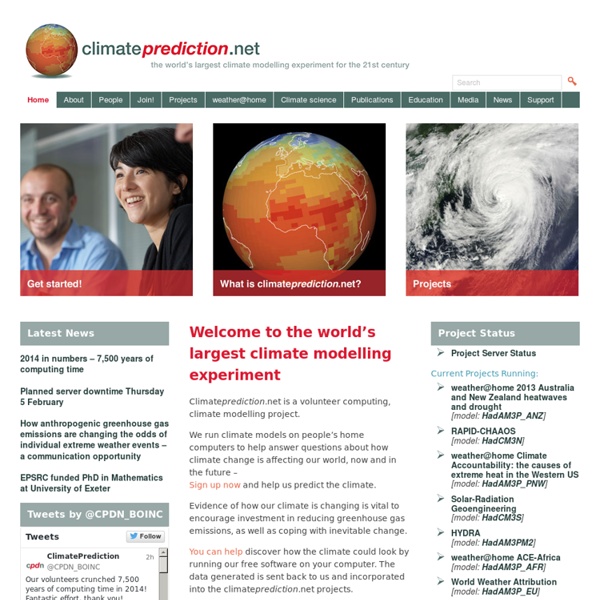



Solve Puzzles for Science | Foldit The Science Network AQUA@home MilkyWay@home Pacific Sea Level Monitoring Project The Pacific Sea Level Monitoring (PSLM), operates under the Climate and Oceans Support Program in the Pacific (COSPPac). It is a continuation of the 20-year South Pacific Sea Level and Climate Monitoring Project (SPSLCMP) The 14 Pacific Island countries participating in the project are the Cook Islands, Federated States of Micronesia, Fiji, Kiribati, Marshall Islands, Nauru, Niue, Palau, Papua New Guinea, Samoa, Solomon Islands, Tonga, Tuvalu and Vanuatu. The primary goal of the project is to generate an accurate record of variance in long-term sea level for the Pacific region. The project also provides information about the processes, scale and implications of sea-level rise and variability of extreme events on South Pacific communities. It also makes sea-level data more readily available and usable to support management of coastal infrastructure and industries. Pacific Region Data Products and Reports Archived Data Products Pacific Sea-Level Monitoring Network
Beyond Belief: Candles in the Dark BEYOND BELIEF DVDs are now available! Purchase them here. Beyond Belief: Candles in the Dark DVDs will be available soon. Beyond Belief: Candles in the Dark is the third in an annual series of conversations: an ongoing project to foster and promote the use of reason in formulating social policy. In The Demon-Haunted World, Carl Sagan wrote: Science is more than a body of knowledge; it is a way of thinking. At The Science Network, we embrace scientific meliorism (last year's meeting, after all, was entitled Enlightenment 2.0). This U.S. election year, when science and reason in the nation's deliberations have been repeatedly challenged as irrelevant or elitist, and science seems to be estranged from society, Sagan's words sound prophetic -- an alarm call. Download the program here Friday, October 3, 2008 Saturday, October 4, 2008 Sunday, October 5, 2008 Here is a list of participants for this event. Peter Atkins Patricia Churchland Paul Davies Nita Farahany Owen Flanagan Jonathan Glover Sam Harris
SETI@home Rosetta@home Fluorescent proteins designed from scratch Congrats to all Rosetta@home volunteers who contributed to a recent report in Nature describing the design of a completely artificial fluorescent beta-barrel protein. As described by one of the main authors, Anastassia, in this forum post: The paper presents many “firsts” in computational protein design. It is the first de novo design of the beta-barrel fold (one of the most described folds in the past 35 years, yet mysterious until now). Thanks to all the Rosetta@home volunteers who contributed to the validation of our designed proteins and binding sites. Here is the link to the IPD webpage that contains a copy of the paper. 17 Sep 2018, 23:14:21 UTC · Discuss ... more atlantiksolar | A UAV for the first-ever autonomous solar-powered crossing of the Atlantic Ocean
"There Was No Big Bang!" Say Several Leading Cosmologists (A Galaxy Classic) "What banged?" Sean Carroll, CalTech -Moore Center for Theoretical Cosmology & Physics Several of the worlds leading astrophysicists believe there was no Big Bang that brought the universe and time into existence. Before the Big Bang, the standard theory assumes, there was no space, just nothing. Einstein merged the universe into a single entity: not space, not time, but spacetime. Proponents of branes propose that we are trapped in a thin membrane of space-time embedded in a much larger cosmos from which neither light nor energy -except gravity- can escape or enter and that that "dark matter" is just the rest of the universe that we can't see because light can't escape from or enter into our membrane from the great bulk of the universe. Perhaps not surprisingly, there is no supportative data to date for Big Bang theory, although the results aren't sensitive enough to rule out the pervasive Big Bang/inflation model. Are branes the key to understanding the origin of our universe?
BOINC malariacontrol.net Nanotubes and Buckyballs Home > Introduction > Nanotubes and Buckyballs Last Updated: Tuesday, 29-May-2012 06:53:42 PDT Go directly to Websites Nanotube: "Conceptually, single-wall carbon nanotubes (SWCNTs) can be considered to be formed by the rolling of a single layer of graphite (called a graphene layer) into a seamless cylinder. A multiwall carbon nanotube (MWCNT) can similarly be considered to be a coaxial assembly of cylinders of SWCNTs, like a Russian doll, one within another; the separation between tubes is about equal to that between the layers in natural graphite. A one dimensional fullerene (a convex cage of atoms with only hexagonal and/or pentagonal faces) with a cylindrical shape. Strictly speaking, any tube with nanoscale dimensions, but generally used to refer to carbon nanotubes, which are sheets of graphite rolled up to make a tube. Nanotubes can be either electrically conductive or semiconductive, depending on their helicity, leading to nanoscale wires and electrical components. Bucky Ball:
Beyond Belief: Enlightenment 2.0 BEYOND BELIEF DVDs are now available! Purchase them here. The aim of Beyond Belief: Enlightenment 2.0 is to invite participants to undertake together an ongoing reconnaissance of Enlightenment ideas in the light of advances in primarily cognitive neurosciences, evolutionary biology, physics etc. though not by any means scanting history, philosophy, law. The word reconnaissance is used advisedly. This is the sequel to Beyond Belief 1 - and the second in what we now are planning to be an annual series of conversations on this topic. Clearly, the religion/faith/belief issue will come up again - as it has most recently concerning Islamic science in the pages of Nature (with thoughts of Ziauddin Sardar's Commentary on 12 July, and Sam Harris' letter on August 23). We shall also re-visit some of last year's questions including: Can evolutionary biology, anthropology and neuroscience help us to better understand how we construct beliefs, and experience empathy, fear and awe?